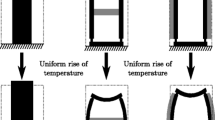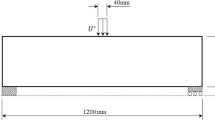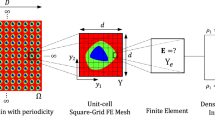Abstract
The present contribution deals with a gradient based optimization strategy to improve the ductility of composite structures. In order to achieve the chosen optimization goal, stiff inclusions in a soft matrix are varied in shape and location controlled by the variation of implicit level-set functions. The eXtended Finite Element Method (XFEM) allows the use of a fixed structured mesh. For the non-linear constitutive behaviour an isotropic damage model is chosen for interface and matrix softening failure; the inclusions are assumed to be elastic. For the calculation of the required sensitivities the influence of the material interfaces, the related enrichment funcions of the X-FEM as well as the kinematic and constitutive relations have to be taken into account.














Similar content being viewed by others

References
Allaire G, Jouve F, Toader AM (2004) Structural optimization using sensitivity analysis and a level-set method. J Comput Phys 194:363–393
Belytschko T, Black T (1999) Elastic crack growth in finite elements with minimal remeshing. Int J Numer Meth Engng 45:601– 620
Bendsøe M, Kikuchi N (1988) Generating optimal topologies in structural design using a homogenization method. Comput Methods Appl Mech Engrg 71:197–224
Bendsøe MP, Sigmund O (2003) Topology optimization: Theory, methods and applications. Springer-Verlag, Berlin, Heidelberg
Brewer J, Lagace P (1988) Quadratic stress criterion for initiation of delamination. J Compos Mater 22:1141–1155
Choi K, Kim N (2005) Structural sensitivity analysis and optimization 1/2. Springer-Verlag, Berlin, Heidelberg
Curbach M, Jesse F (2009) Eigenschaften und Anwendung von Textilbeton. Beton- und Stahlbetonbau 104(1):9–16
Daux C, Moës N, Dolbow J, Sukumar N, Belytschko T (2000) Arbitrary branched and intersecting cracks with the extended finite element method. Int J Numer Meth Engng 48:1741–1760
Duysinx P, Van Miegroet L, Jacobs T, Fleury C (2006) Generalized shape optimization using x-fem and level set methods. In: Bendsøe MP, Olhoff N, Sigmund O (eds) IUTAM symposium on topological design optimization of structures, machines and materials. Solid mechanics and its applications, vol 137. Springer-Verlag, Berlin, Heidelberg, pp 23–32
Farsad M, Vernerey F, Park H (2010) An extended finite element/level set method to study surface effects on the mechanical behavior and properties of nanomaterials. Int J Numer Meth Engng 84:1466–1489
Foldager J, Hansen J, Olhoff N (1998) A general approach forcing convexity of ply angle optimization in composite laminates. Struct Multidiscip Optim 16:201–211
Gibiansky L, Sigmund O (2000) Multiphase composites with extremal bulk modulus. J Mech Phys Solids 48(3):461–498
Hammer V (1999) Optimal laminate design subject to single membrane loads. Struct Multidiscip Optim 17:65–73
Hegger J, Will N, Bruckermann O, Voss S (2006) Load-bearing behaviour and simulation of textile reinforced concrete. Mater Struct 39:765–776
Hilchenbach C (2010) Optimierung von Mehrphasenstrukturen mit lokalem Schädigungsverhalten (Optimization of Composites with Interface and Matrix Failure). Ph.D. thesis, Bericht Nr. 54, Institut für Baustatik und Baudynamik, Universität Stuttgart. http://elib.uni-stuttgart.de/opus/volltexte/2011/6146/
Hui C, Ruina A, Long R, Jagota A (2011) Cohesive zone models and fracture. J Adhes 87(1):1–52
Karihaloo B, Lange-Kornbak D (2001) Optimization techniques for the design of high-performance fiber-reinforced concrete. Struct Multidiscip Optim 21:32–39
Kato J (2010) Material optimization for fiber reinforced composites applying a damage formulation. Ph.D. thesis, Bericht Nr. 53, Institut für Baustatik und Baudynamik, Universität Stuttgart. http://elib.uni-stuttgart.de/opus/volltexte/2010/5162/
Kato J, Ramm E (2010) Optimization of fiber geometry for fiber reinforced composites considering damage. Finite Elem Anal Des 46:401–415
Kato J, Ramm E (2013) Multiphase layout optimization for fiber reinforced composites considering a damage model. Eng Struct 49:202–220
Kato J, Lipka A, Ramm E (2009) Multiphase material optimization for fiber reinforced composites with strain softening. Struct Multidiscip Optim 39:63–81
Kemmler R (2004) Stabilität und große Verschiebungen in der Topologie- und Formoptimierung (Stability and large Deformations in Topology and Shape Optimization). Ph.D. thesis, Bericht Nr. 41, Institut für Baustatik und Baudynamik, Universität Stuttgart. http://elib.uni-stuttgart.de/opus/volltexte/2004/1636/
Kemmler R, Lipka A, Ramm E (2005) Large deformations and stability in topology optimization. Struct Multidiscip Optim 30:459–476
Lipka A (2007) Verbesserter Materialeinsatz innovativer Werkstoffe durch die Topologieoptimierung (Improved Design of Innovative Materials by Topology Optimization). Ph.D. thesis, Bericht Nr. 47, Institut für Baustatik und Baudynamik, Universität Stuttgart. http://elib.uni-stuttgart.de/opus/voll-texte/2007/3225/
Liu Z, Korvink J, Huang R (2005) Structure topology optimization: fully coupled level set method via femlab. Struct Multidiscip Optim 29:407–417
Luo Z, Wang M, Wang S, Wei P (2008) A level set-based parameterization method for structural shape and topology optimization. Int J Numer Meth Engng 76:1–26
Maute K (1998) Topologie- und Formoptimierung von dünnwandigen Flächentragwerken (Topology and Shape Optimization of Thin-walled Structures). Ph.D. thesis, Bericht Nr. 47, Institut für Baustatik und Baudynamik, Universität Stuttgart. http://www.ibb.uni-stuttgart.de/publikationen/fulltext/1998/maute-1998.pdf
Melenk J, Babus̆ka I (1996) The partition of unity finite element method: Basic theory and applications. Comput Methods Appl Mech Engrg 139(1-4):289–314
Moës N, Dolbow J, Belytschko T (1999) A finite element method for crack growth without remeshing. Int J Numer Meth Engng 46:131–150
Mosler J, Scheider I (2011) A thermodynamically and variationally consistent class of damage-type cohesive models. J Mech Phys Solids 59(8):1647–1668
Olhoff N, Lurie K, Cherkaev A, Fedorov A (1981) Sliding regimes and anisotropy in optimal design of vibrating axisymmetric plates. Int J Solids Struct 17(10):931–948
Ortiz M, Pandolfi A (1999) Finite-deformation irreversible cohesive elements for three-dimensional crack-propagation analysis. Int J Numer Meth Engng 44:1267–1282
Osher S, Sethian J (1988) Fronts propagating with curvature-dependent speed: Algorithms based on Hamilton-Jacobi formulations. J Comput Phys 79:12–49
Park K, Paulino G, Roesler J (2009) A unified potential-based cohesive model of mixed-mode fracture. J Mech Phys Solids 57(6):891–908
Patnaik S, Guptill J, Berke L (1995) Merits and limitations of optimality criteria method for structural optimization. Int J Numer Meth Engng 38:3087–3120
Prechtel M, Leugering G, Steinmann P, Stingl M (2012) Optimal design of brittle composite materials: A nonsmooth approach. J Opt Theory & Appl 155(3):962–985
RILEM (The International Union of Testing and Research Laboratories for Materials and Structures) (2006) Report rep036: Reinforced Concrete - State-of-the-Art Report of RILEM TC 201-TRC, ed. Brameshuber W
Rodrigues H, Soto CA, Taylor JE (1999) A design model to predict optimal two-material composite structures. Struct Multidiscip Optim 17(2-3):186–198
Rose J, Smith J, Ferrante J (1981) Universal binding energy curves for metals and bimetallic interfaces. Phys Rev Lett 47:675– 678
Rotthaus M, Barthold FJ (2008) Structural optimization of multi-material structures. In: Toropov VV, Querin OM, Kim HA, Butler R, Sienz J (eds) Proceedings of the 7th asmo UK conference on engineering design optimization, pp 354– 367
Sigmund O (2000) A new class of extremal composites. J Mech Phys Solids 48(2):397–428
Sigmund O, Torquato S (1997) Design of materials with extreme thermal expansion using a three-phase topology optimization method. J Mech Phys Solids 45(6):1037–1067
Stegmann J, Lund E (2005) Discrete material optimization of general composite shell structures. Int J Numer Meth Engng 62:2009–2027
Stolpe M, Stegmann J (2008) A newton method for solving continuous multiple material minimum compliance problems. Struct Multidiscip Optim 35:93–106
Svanberg K (1987) The method of moving asymptotes - a new method for structural optimization. Int J Numer Meth Engng 24:359– 373
Svanberg K (2011) MMA and GCMMA, versions September 2007. http://www.math.kth.se/krille/
Vigdergauz S (2007) Shape optimization of a rigid inclusion in a shear-loaded elastic plane. J Mech Mat Struct 2(2):275– 291
Zhang J, Paulino G, Celes W (2007) Extrinsic cohesive modelling of dynamic fracture and microbranching instability in brittle materials. Int J Numer Meth Engng 72(8):893–923
Zhou M, Rozvany G (1991) The COC algorithm, part II: Topological, geometrical and generalized shape optimization. Comput Methods Appl Mech Engrg 89:309–336
Acknowledgments
The present study has been partially sponsored by the Research Center of Excellence “Simulation Technology” of the University of Stuttgart supported by the Deutsche Forschungsgemeinschaft DFG (German Research Foundation); this support is gratefully acknowledged. The authors also thank Professor Manfred Bischoff for his continuous valuable advice.
Author information
Authors and Affiliations
Corresponding author
Rights and permissions
About this article
Cite this article
Hilchenbach, C.F., Ramm, E. Optimization of multiphase structures considering damage. Struct Multidisc Optim 51, 1083–1096 (2015). https://doi.org/10.1007/s00158-014-1198-4
Received:
Revised:
Accepted:
Published:
Issue Date:
DOI: https://doi.org/10.1007/s00158-014-1198-4



